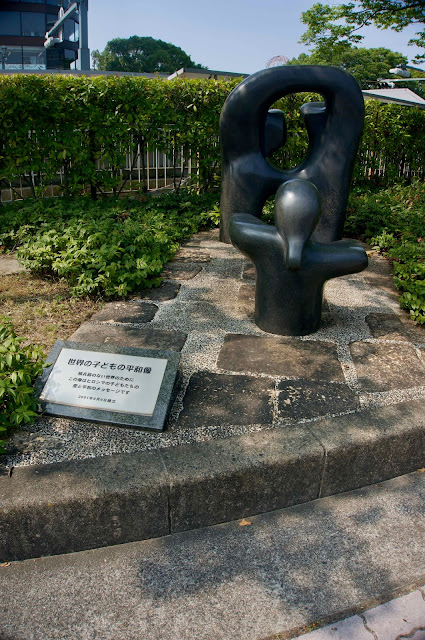50 Monument for the A-bomb Victims from the Hiroshima Agricultural Association
Date of completion August 6, 1971
Established by JA Hiroshima Chuou Kai, JA Hiroshima Shinren, JA Hiroshima Keizairen, Hiroshima Doeisha Kyosairen and JA Hiroshima Kouseiren
Shape
The cenotaph is made of black granite (1-meter high, 2-meters wide).
Motive for the erection
To console the spirits of 83 A-bomb victims of the Hiroshima Agricultural Association (including those who died of atomic bomb-related diseases)
Epigraph
"Monument for the A-bomb Victims from the Hiroshima Agricultural Association" (Words written by Noboru Okuhisa, President of the Hiroshima Agricultural Association)
"The atomic bomb that exploded over Hiroshima at 8:15 a.m. on August 6, 1945 devastated the entire city in an instant, turning it into hell on earth. The inferno reduced the towns in Hiroshima to ruins and victimized some 80 of the executives and employees of the Hiroshima Agricultural Association. To console the spirits of the victims, this cenotaph has been erected close to where the Hiroshima Branch was located. (August 6, 1971)"
(Words composed by Mamoru Yukihiro, President of Hiroshima Doeisha Kyosairen)
(Words written by Jitsuo Ito, President of JA Hiroshima Chuou Kai)
Noteworthy characteristics
1. The Hiroshima Agricultural Association
Each day, some 200 staff members commuted to the association's head office, a modern two-story wooden building built in September 1942 on the south side of Hiroshima City Hall (near where the Hiroshima National Building stands today).
Immediately after the atomic bombing, 71 staff members were confirmed dead and 72 were seriously injured. Many more died later.
2. Hiroshima Branch of The Hiroshima Agricultural Association
The Hiroshima Branch of the Hiroshima Agricultural Association was located where this cenotaph stands today.
From the former Hiroshima Agricultural and Industrial Bank, the Hiroshima Agricultural Association received title to a four-story, six-columned brick building that the association used as its head office. After the head office had moved to a new location in Kokutaiji-machi, the original building was used as the association's Hiroshima Branch. The atomic bomb completely devastated the building; only some portions of the exterior walls remained standing. Since thick bricks had been used in constructing the building, the wreckage was too hot to touch for some time after the bombing. After about a week, survivors broke up the bricks to collect the remains of the dead underneath.
All staff, including the branch manager, who were inside the building on that day were victimized by the atomic bomb.





















